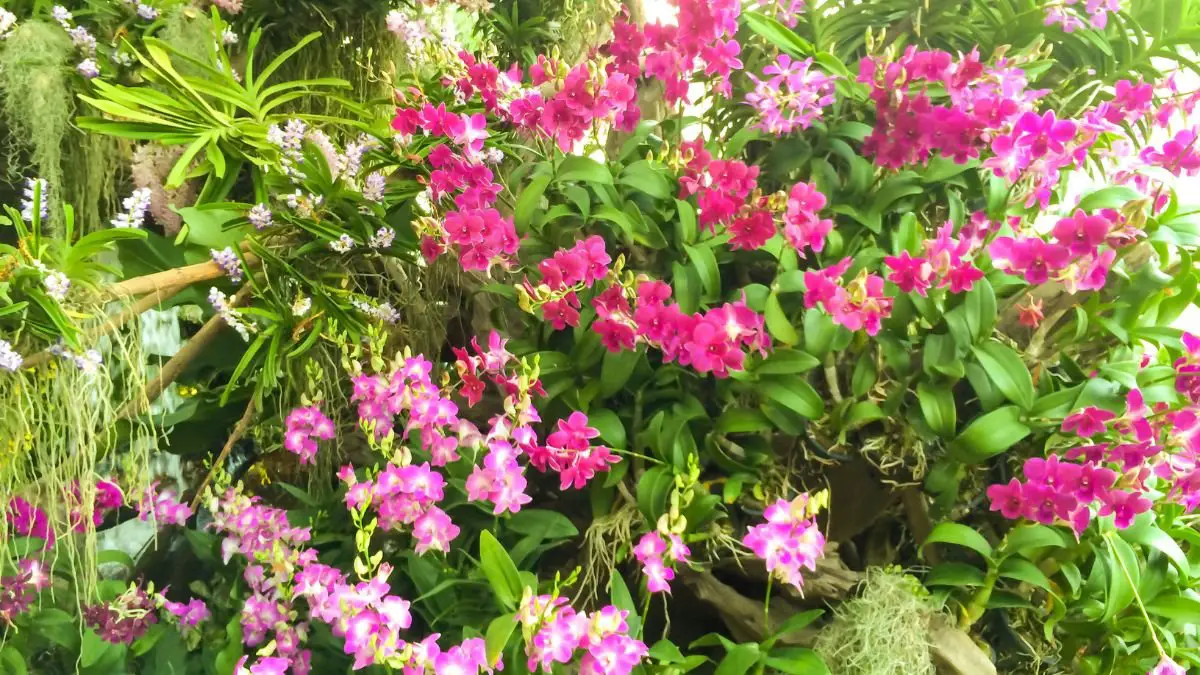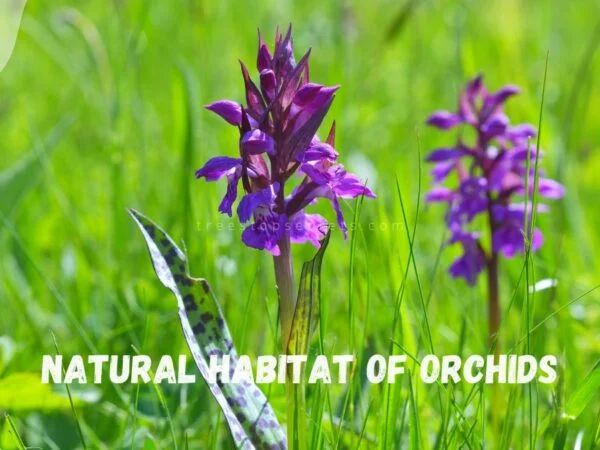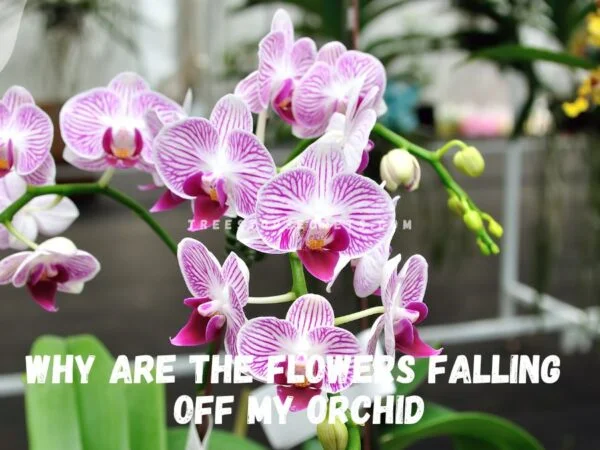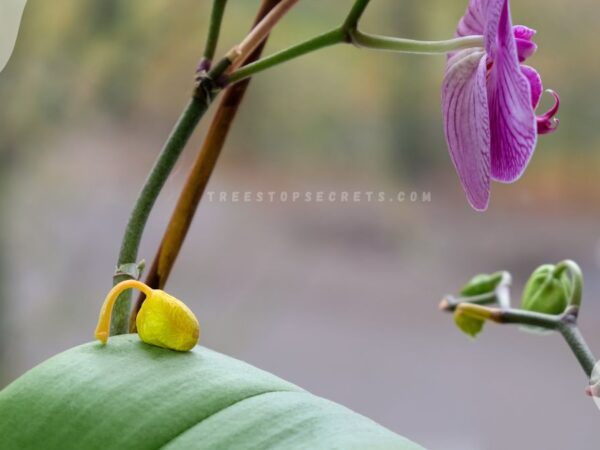Discover the captivating world of orchids with leaves, flowers where delicate beauty meets robust foliage and nature. These stunning plants blend intricate flowers with attractive foliage and lush greenery, creating a striking contrast that mesmerizes any observer. From vibrant colors to graceful shapes, orchids with leaves and flowers offer a unique charm that stands out in any setting. Whether you are a seasoned gardener or a budding enthusiast, exploring the allure of these botanical wonders is sure to inspire and delight. Join us on a journey through the enchanting realm of orchids with leaves and unlock the secrets of their exquisite allure.
Key Takeaways
- Identifying Orchids by Leaves: Pay attention to the shape, color, and texture of orchid leaves to determine the specific type of orchid you have.
- Potting Mix Essentials: Use a well-draining orchid mix with materials like bark, sphagnum moss, and perlite to ensure proper aeration and moisture control for your orchids.
- Orchid Care Based on Leaves: Adjust your watering, light exposure, and feeding schedules based on the characteristics of your orchid's leaves to promote healthy growth.
- Potting and Repotting Tips: Repot orchids when necessary, focusing on the condition of the roots and the health of the plant to ensure continued growth and blooming.
- Common Leaf Problems and Solutions: Monitor your orchid's leaves for signs of discoloration, spots, or pests, and take appropriate actions such as adjusting care routines or applying treatments.
- Enhancing Bloom Production: Create optimal conditions for blooming by providing sufficient light, appropriate temperatures, and proper fertilization tailored to your orchid's blooming cycle.
Identifying Orchids by Leaves
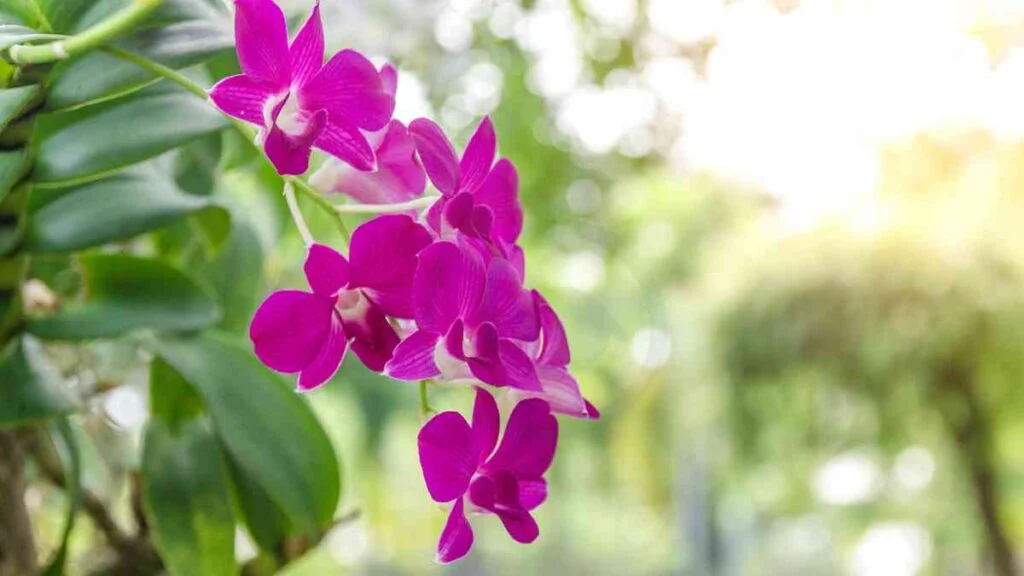
Leaf Shapes
Orchid leaves come in various shapes such as lanceolate, oblong, and elliptical. These shapes play a crucial role in distinguishing one orchid species from another. The lanceolate shape, for example, is long and narrow with pointed ends, while oblong leaves are rectangular with rounded edges. Elliptical leaves are oval-shaped, adding to the diversity of orchid leaf morphology.
Understanding the significance of leaf shapes is essential for accurate orchid identification. Different species exhibit unique leaf shapes that aid botanists and enthusiasts in classifying orchids correctly. By studying the distinct characteristics of each leaf shape, individuals can pinpoint the specific type of orchid they are dealing with. This knowledge enhances precision in cultivating and caring for different orchid varieties.
Each orchid species showcases its distinct leaf shapes, contributing to the vast array of variations within the orchid family. From the elegant lanceolate leaves of Cattleya orchids to the elongated elliptical leaves of Phalaenopsis orchids, observing these differences allows enthusiasts to appreciate the beauty and complexity present in nature's creations.
Leaf Textures
Orchid leaves exhibit diverse textures ranging from smooth to leathery and velvety. These textures not only add tactile appeal but also serve as indicators of an orchid's health and vitality. Smooth-textured leaves are soft to touch, while leathery ones feel firm and robust. Velvety textures provide a delicate feel akin to touching velvet fabric.
The texture of an orchid's leaves plays a vital role in determining its care requirements. Smooth-textured leaves often require more moisture, while leathery textures indicate plants that can withstand drier conditions. Understanding these distinctions helps growers tailor their care routines to meet the specific needs of each orchid variety, promoting optimal growth and blooming.
Differentiating between leaf textures across various orchid types is essential for effective plant maintenance. By recognizing whether an orchid has smooth, leathery, or velvety leaves, growers can adjust watering schedules, humidity levels, and fertilization practices accordingly to ensure the plant thrives in its environment.
Leaf Colors
Orchids display a wide spectrum of leaf colors including green, variegated, and silver hues. The coloration of an orchid's leaves serves as a visual indicator of its overall health status. Vibrant green foliage signals robust growth and photosynthesis activity, while variegated patterns add aesthetic appeal through contrasting colors. Silver-toned leaves often convey elegance and uniqueness in orchid plants.
Leaf colors offer valuable insights into an orchid's well-being by reflecting its nutrient uptake, light exposure, and hydration levels. Monitoring changes in leaf color can alert growers to potential issues such as nutrient deficiencies or diseases early on, enabling prompt intervention to maintain plant health.
The role of leaf colors extends beyond mere aesthetics; it plays a significant part in enhancing the visual allure of orchids. Whether showcasing rich green tones in Dendrobium leaves or intricate variegation patterns in Miltoniopsis foliage, each color variation contributes to the overall charm and attractiveness of these exquisite flowering plants.
Leaf Patterns
Unique leaf patterns like stripes, spots, and mottling are distinctive features found across various orchid species. These patterns add character and flair to the appearance of orchid plants, setting them apart from one another visually. Striped patterns create dynamic contrasts on leaves, while spots add whimsy and intrigue. Mottled patterns produce intricate designs resembling marbling effects on foliage surfaces.
The intricate details within leaf patterns significantly influence the overall aesthetic
Potting Mix Essentials
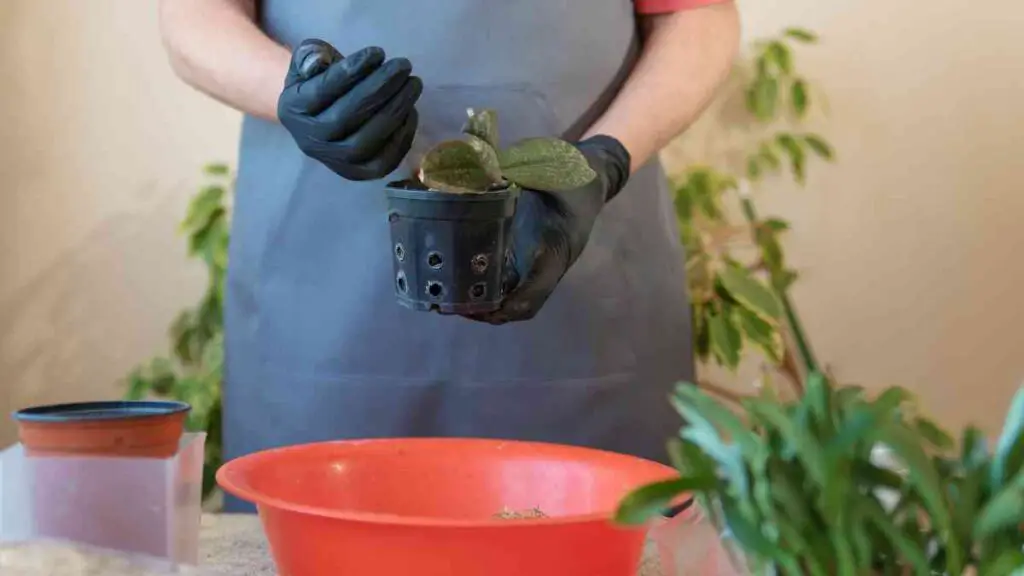
Brassavola and Catasetum
Brassavola orchids are known for their fragrant blooms that perfume the surrounding air with a delightful scent. These orchids typically feature long, thin leaves and elegant white flowers.
On the other hand, Catasetum orchids exhibit a unique deciduous nature, shedding their leaves in the fall as they enter a period of dormancy. During winter, these orchids require reduced watering to simulate their natural rest period.
When caring for Brassavola and Catasetum orchids, it is crucial to provide them with bright indirect light and a well-draining potting mix. Watering should be done thoroughly but infrequently to prevent waterlogged roots.
Cattleya Varieties
Cattleya orchids are renowned for their striking pseudobulbs that store water and nutrients, supporting the plant during dry periods. These orchids produce large, vibrant blooms in an array of colors and patterns.
With various types of Cattleya orchids available, each variety showcases unique features such as lip shape, size of blooms, and growth habits. From miniature varieties to large hybrids, Cattleyas offer diversity in appearance and care requirements.
To ensure optimal growth, Cattleya orchids need ample sunlight, good air circulation, and a well-draining potting mix. Regular fertilization during the growing season supports healthy development and abundant flowering.
Dendrobium and Epidendrum
Dendrobium orchids stand out with their tall stature and elongated pseudobulbs that bear clusters of colorful flowers along the stem. These orchids prefer bright light but protection from direct sun to prevent leaf burn.
In contrast, Epidendrum orchids feature chunky pseudobulbs topped with delicate fragrant blooms in various hues. Their compact size makes them ideal for windowsills or small spaces where they can receive indirect sunlight throughout the day.
When potting Dendrobiums or Epidendrums, use a mix that provides good drainage while retaining some moisture. It's essential to repot these orchids every few years to refresh the potting medium and ensure continued growth.
Special Mixes for Unique Orchids
For unique orchid varieties like Lycaste and Cycnoches, specialized potting mixes are recommended to meet their specific needs. These mixes often include ingredients like bark chips, perlite, sphagnum moss, or charcoal to create a balanced environment for root health.
Creating custom potting mixes tailored to different orchid types is crucial for promoting healthy growth and blooming cycles. The right mix ensures proper aeration around the roots while retaining enough moisture to sustain the plant between waterings.
Orchid Care Based on Leaves
Watering Needs
Orchids like Phragmipedium and Vanda have specific watering requirements. Phragmipedium, for example, prefers consistently moist conditions, while Vanda orchids need to dry out between waterings. Maintaining proper moisture levels is crucial for healthy orchid growth as it prevents root rot and dehydration. Adjust watering schedules based on seasonal changes; decrease frequency in winter and increase in summer to accommodate varying humidity levels.
Light Requirements
Different orchids, such as Phalaenopsis and Oncidium, have unique light preferences. Phalaenopsis thrives in bright, indirect light, while Oncidium prefers more direct sunlight. Providing adequate light conditions is essential for orchids to bloom and grow vigorously. Adjust the exposure of light based on the specific needs of each orchid species; use sheer curtains or blinds to filter intense sunlight for light-sensitive varieties like Phalaenopsis.
Specific Orchid Types and Their Care
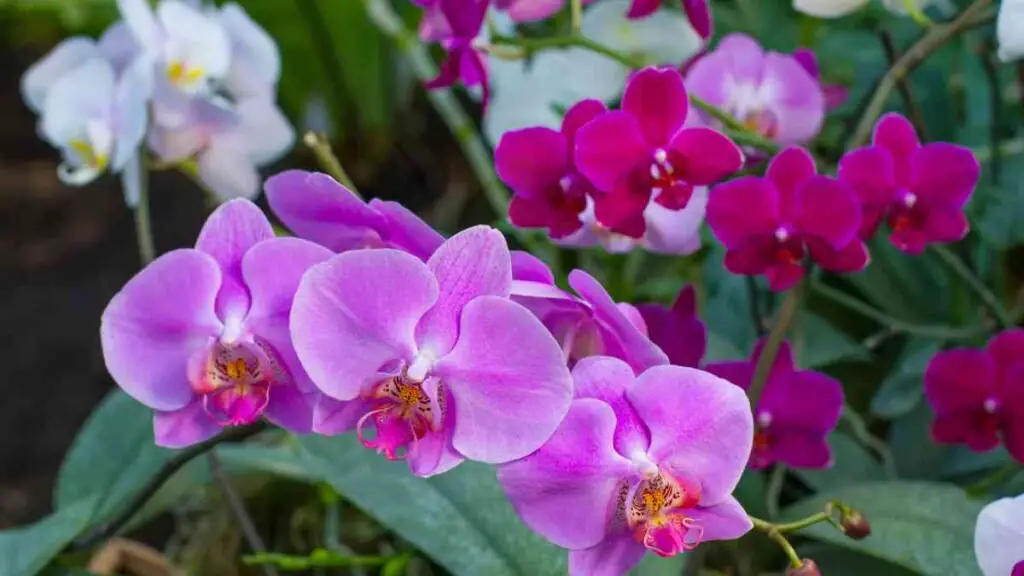
Miniature Orchids
Miniature orchids, like Phalaenopsis and Dendrobiums, are perfect for small spaces due to their compact size. These orchids require bright, indirect light and consistent watering to thrive. Remember to avoid overwatering as it can lead to root rot.
- Pros:
- Ideal for small living spaces
- Beautiful blooms in a compact size
- Cons:
- Require regular monitoring of watering needs
- Prone to overwatering if not careful
Slipper Orchids
Slipper orchids, such as Paphiopedilum, are known for their unique slipper-shaped pouches. These orchids prefer low light conditions and well-draining soil. Ensure you water them thoroughly but allow the soil to dry slightly between waterings.
- Place slipper orchids in shaded areas
- Use a well-draining potting mix specifically for orchids
Vanda Orchids
Vanda orchids are stunning with vibrant colors and large blooms. They require bright, indirect light, high humidity levels, and good air circulation. Water vanda orchids early in the day so that any excess moisture can evaporate before nightfall.
- Key Information:
- Bright, indirect light is crucial
- High humidity levels are necessary for optimal growth
Oncidium Orchids
Oncidium orchids, also known as dancing lady orchids, feature delicate flowers on long arching stems. These orchids thrive in bright, indirect light and prefer to dry out slightly between waterings. Fertilize them regularly during the growing season to promote healthy growth.
- List of Examples:
- Oncidium Sharry Baby
- Oncidium Twinkle
- Oncidium Heaven Scent
Potting and Repotting Tips
Choosing the Right Pot
When selecting a pot for your orchid with leaves, opt for one with ample drainage holes. These holes prevent waterlogging, crucial for orchids' health. Choose a pot that is slightly larger than the plant's current root system to allow space for growth.
Ensure the pot material is breathable, such as clay or plastic. This allows air circulation around the roots, promoting healthy growth. Avoid pots that retain excess moisture, like glass containers, as they can lead to root rot.
When to Repot
Orchids with leaves typically need repotting every 1-2 years to refresh their growing medium. Signs it's time to repot include overcrowded roots spilling over the pot's edges and slow growth despite proper care. Spring is an ideal time for repotting when new growth emerges.
Inspect the roots carefully during repotting; healthy roots are firm and green, while rotted ones are mushy and brown. Trim any damaged roots before repotting your orchid to encourage new growth and prevent the spread of disease.
Potting Mix Recipe
Create a well-draining potting mix for your orchid with leaves by combining materials like fir bark, sphagnum moss, perlite, and charcoal in equal parts. This mix mimics orchids' natural epiphytic growing conditions, ensuring optimal aeration and drainage.
List:
- Fir bark
- Sphagnum moss
- Perlite
- Charcoal
Avoid using standard potting soil, which retains too much moisture and can suffocate orchid roots. The coarse texture of the specialized mix provides stability for the plant while allowing excess water to drain freely.
Common Leaf Problems and Solutions
Yellowing Leaves
Yellowing leaves on an orchid can be a sign of various issues, such as overwatering or inadequate light. To address this problem, ensure proper drainage in the pot and adjust the lighting conditions accordingly. Consider repotting the orchid if root rot is suspected due to overwatering.
- Causes: Overwatering, insufficient light
- Solutions: Improve drainage, adjust lighting, repot if necessary
Spotted Leaves
Spotted leaves can indicate fungal or bacterial infections in orchids. Preventive measures include maintaining good air circulation around the plant and avoiding overhead watering. Treatment options may involve using fungicides or removing affected leaves carefully.
- Causes: Fungal or bacterial infections
- Prevention: Good air circulation, avoid overhead watering
- Treatment: Fungicides, careful removal of affected leaves
Droopy Leaves
Droopy leaves are often a result of underwatering or root issues in orchids. Ensure proper watering by allowing the roots to dry slightly between waterings. Inspect the roots for any signs of rot and consider repotting if necessary for root health.
- Causes: Underwatering, root problems
- Solution: Proper watering schedule, check for root health regularly
Enhancing Bloom Production
Light Exposure
Orchids thrive in indirect sunlight, requiring around 12-14 hours of light daily for optimal bloom production.
To enhance bloom growth, place orchids near east-facing windows to receive gentle morning sun.
Avoid direct sunlight as it can scorch the leaves and hinder blooming progress.
Temperature Control
Maintain a consistent temperature range of 65-75°F during the day and slightly cooler at night for orchids to bloom effectively.
Sudden temperature fluctuations can stress the plant, leading to leaf drop and reduced blooming.
Use a thermometer to monitor temperatures accurately and adjust heating or cooling systems accordingly.
Feeding for Blooms
Provide a balanced 20-20-20 orchid fertilizer every 2 weeks during the growing season to promote robust blooms.
Ensure the fertilizer contains essential nutrients like nitrogen, phosphorus, and potassium for healthy flower development.
Over-fertilizing can damage roots, causing leaf discoloration and inhibiting bloom formation.
Seasonal Care Guide
Spring Care Routine
During spring, orchids with leaves require special attention. Increase watering frequency to promote growth. Provide adequate sunlight exposure for optimal development.
Incorporate a balanced fertilizer to support leaf and root growth. Monitor for pests and diseases regularly. Ensure proper ventilation to prevent fungal infections.
Summer Maintenance
Summer demands proper care for orchids with leaves. Maintain consistent watering to prevent dehydration. Shield from direct sunlight during peak hours to avoid leaf scorching.
Implement a humidifier or pebble tray to maintain moisture levels. Prune damaged leaves and repot if necessary. Protect from extreme heat to prevent stress.
Autumn Adjustments
Transitioning into autumn, adjust care for orchids with leaves accordingly. Reduce watering frequency as temperatures cool down. Trim any overgrown or yellowing leaves carefully.
Prepare for lower light conditions by relocating plants strategically. Monitor humidity levels indoors as heating systems can dry the air. Inspect roots for signs of rot due to decreased evaporation rates.
Winter Protection
In winter, prioritize protection for orchids with leaves against cold temperatures. Limit watering to prevent waterlogged soil in lower light conditions. Avoid placing near drafty windows or vents.
Maintain consistent temperatures above 60°F (15°C) to prevent damage. Consider supplemental lighting if natural light is insufficient. Shield from frost by moving away from windows overnight.
Advanced Orchid Care Techniques
Pruning and Grooming
Pruning is crucial for orchid maintenance to ensure healthy growth and blooming. Trim yellow or dead leaves promptly. Remove spent flower spikes to encourage new blooms. Regularly inspect for pests and diseases to prevent spread.
Grooming involves cleaning the leaves using a damp cloth to remove dust and debris. This helps the plant absorb light efficiently. Avoid using harsh chemicals that can damage the delicate foliage. Trim aerial roots only when necessary, ensuring they remain green and plump.
- Pros:
- Promotes healthy growth
- Enhances aesthetic appeal
- Cons:
- Over-pruning can stress the plant
Pest and Disease Management
Pests like aphids, mealybugs, and spider mites can harm orchids. Use insecticidal soap or neem oil for organic control. Isolate infected plants to prevent spread. For fungal diseases, like root rot, improve air circulation and avoid overwatering.
Regularly inspect your orchids for early signs of pests or diseases to take immediate action. Quarantine newly acquired plants to prevent introducing infections to your collection. Implement good cultural practices like proper watering and adequate lighting to boost plant immunity.
- Key Tips:
- Monitor regularly for pest infestations
- Act promptly at the first sign of disease
Propagation Methods
Orchids can be propagated through division, back bulbs, keiki, or seed sowing. Division involves separating overcrowded plants into smaller sections with roots attached. Back bulbs are mature pseudobulbs capable of producing new growths when planted.
Keikis are baby plants that develop on flower spikes or nodes of certain orchid species. These can be detached once they have roots of their own for individual potting. Seed sowing is a more complex method suitable for experienced growers due to its intricacies.
- Division:
- Separate overcrowded plants
- Ensure each section has roots attached
- Back Bulbs:
- Plant mature pseudobulbs for new growths
- Keiki:
- Detach once roots develop
- Pot individually
- Seed Sowing:
- Complex method recommended for experienced growers
Final Remarks
You've now gained valuable insights into identifying orchids by their leaves, essential potting mix requirements, care techniques based on leaf characteristics, specific orchid types and their unique care needs, potting and repotting tips, common leaf issues and solutions, strategies to enhance bloom production, a seasonal care guide, and advanced care techniques. By mastering these aspects, you're well-equipped to nurture healthy and thriving orchids in your own space.
Take the knowledge you've acquired here and put it into action. Your orchids will flourish under your expert care. Keep exploring new techniques and stay curious about the fascinating world of orchids. Remember, a little attention to detail goes a long way in creating a vibrant and blooming orchid collection!
Frequently Asked Questions
How can I identify orchids by their leaves?
Orchids can be identified by examining the shape, color, texture, and arrangement of their leaves. Each orchid species has unique leaf characteristics that can help in identification. Look for specific patterns or markings on the leaves to distinguish between different types of orchids.
What are some common leaf problems in orchids?
Common leaf problems in orchids include yellowing, browning, spotting, and wilting. These issues can be caused by overwatering, underwatering, pests, diseases, or incorrect lighting conditions. Regularly inspect your orchid's leaves for any signs of discoloration or damage to address problems promptly.
How do I enhance bloom production in my orchids?
To enhance bloom production in your orchids, ensure they receive adequate light, water, and nutrients. Prune dead blooms and provide proper care based on the specific type of orchid you have. Implement a regular fertilizing schedule and maintain optimal growing conditions to promote healthy blooming.
What are some advanced care techniques for orchids?
Advanced care techniques for orchids include customizing fertilization schedules based on growth stages, implementing specialized potting mixes tailored to each orchid type, using humidity trays or misting systems for moisture control, and experimenting with different light spectrums for optimal growth. These techniques require careful monitoring and expertise.
When should I repot my orchid?
Repot your orchid when you notice overcrowded roots spilling over the pot edges or when the potting mix breaks down and becomes soggy. Typically, it is recommended to repot every 1-2 years after flowering to refresh the growing medium and provide ample space for root growth.
Image Source: Paid image from CANVA

